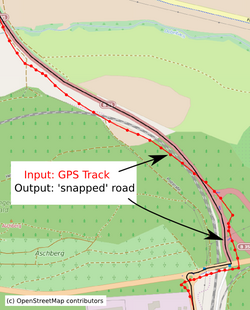Map matching
Map matching is the problem of how to match recorded geographic coordinates to a logical model of the real world, typically using some form of Geographic Information System. The most common approach is to take recorded, serial location points (e.g. from GPS) and relate them to edges in an existing street graph (network), usually in a sorted list representing the travel of a user or vehicle. Matching observations to a logical model in this way has applications in satellites navigation, GPS tracking of freight, and transportation engineering.
Map matching algorithms can be divided in real-time and offline algorithms. Real-time algorithms associate the position during the recording process to the road network. Offline algorithms are used after the data is recorded and are then matched to the road network.[1] Real-time applications can only calculate based upon the points prior to a given time (as opposed to those of a whole journey), but are intended to be used in 'live' environments. This brings a compromise of performance over accuracy. Offline applications can consider all points and so can tolerate slower performance in favour of accuracy. However, the defects on low accuracy can be reduced due to integration of spatio-temporal proximity and improved weighted circle algorithms.[2]
Examples and use cases
Uses for map-matching algorithms range from the immediate and practical, such as applications designed for guiding travellers, to the analytical, such as generating detailed inputs for traffic analysis models and the like.
Probably the most common use of map-matching is where a traveller has some mobile computer giving him or her directions across a street network. In order to give accurate directions, the device must know exactly where in the street network the user is. A GPS location has positional error though, so picking the nearest street segment and routing from there will likely not work. Instead, the history of locations reported by the GPS can be used to guess a plausible route and infer the current location more accurately.
Other uses, more analytical in nature, include:
- extracting traffic flow information from vehicle GPS tracks
- associating user-reported attributes with a street
- automatically infer turn restrictions based on an analysis of multiple GPS tracks
There are other examples [3] and this subject is still undergoing active research and development.[4][5][6][7]
Approaches
Geometric approach
The earliest approached to solve the map matching problem based on similarity between points' curve and the road curve.[8]
Hidden Markov Models
Map matching is described as a hidden Markov model where emission probability is a confidence of a point to belong a single segment, and the transition probability is presented as possibility of a point to move from one segment to another within a given time.[9][10]
Implementation
Map matching is implemented in a variety of programs,[11][12] including the open-source GraphHopper and Open Source Routing Machine routing engines.[13] It is also included in a variety of proprietary programs and mapping/routing applications.
References
- ↑ Pereira, Francisco Câmara; Costa, Hugo; Pereira, Nuno Martinho (2009-09-11). "An off-line map-matching algorithm for incompletemap databases". European Transport Research Review 1 (3): 107–124. doi:10.1007/s12544-009-0013-6. https://www.academia.edu/1869728. Retrieved 2014-11-23.
- ↑ Teng, Wenxin; Wang, Yanhui (8 July 2019). "Real-Time Map Matching: A New Algorithm Integrating Spatio-Temporal Proximity and Improved Weighted Circle". Open Geosciences 11 (1): 288–297. doi:10.1515/geo-2019-0023. Bibcode: 2019OGeo...11...23T.
- ↑ Brakatsoulas, Sotiris; Pfoser, Dieter; Wenk, Carola; Salas, Randall (September 2, 2005). "On Map-Matching Vehicle Tracking Data" (PowerPoint). Proc. VLDB conference 2005. http://www.vldb.org/archives/website/2005/program/slides/fri/s853-brakatsoulas.ppt.
- ↑ Yin Lou; Chengyang Zhang; Yu Zheng; Xing Xie; Wei Wang; Yan Huang (November 4, 2009). "Map-Matching for Low-Sampling-Rate GPS Trajectories". Microsoft Research. http://research.microsoft.com/apps/pubs/default.aspx?id=105051.
- ↑ "Efficient map-matching of large GPS data sets - Tests on a speed monitoring experiment in Zurich". July 2004. http://www.strc.ch/conferences/2005/Marchal.pdf.
- ↑ "Map-matching of GPS traces on high-resolution navigation networks using the Multiple Hypothesis Technique (MHT)". October 2009. https://edit.ethz.ch/ivt/vpl/publications/reports/ab568.pdf.[yes|permanent dead link|dead link}}]
- ↑ Willard (October 2013). "Real-time On and Off Road GPS Tracking". arXiv:1303.1883 [stat.AP].
- ↑ Bernstein, David; Kornhauser, Alain (1996-08-01). New Jersey Institute of Technology. ed (in English). An Introduction to Map Matching for Personal Navigation Assistants. https://rosap.ntl.bts.gov/view/dot/38257.
- ↑ Newson, Paul; Krumm, John (November 2009). "Hidden Markov Map Matching Through Noise and Sparseness" (in en). I17th ACM SIGSPATIAL International Conference on Advances in Geographic Information Systems (ACM SIGSPATIAL GIS 2009). https://www.microsoft.com/en-us/research/publication/hidden-markov-map-matching-noise-sparseness/.
- ↑ Luo, An; Chen, Shenghua; Xv, Bin (November 2017). "Enhanced Map-Matching Algorithm with a Hidden Markov Model for Mobile Phone Positioning" (in en). ISPRS International Journal of Geo-Information 6 (11): 327. doi:10.3390/ijgi6110327. ISSN 2220-9964. Bibcode: 2017IJGI....6..327L.
- ↑ "Map Tracking". https://www.showmymap.com/proximity-radius-circles/. Retrieved 14 March 2018.
- ↑ "open-tracking-tools". 16 March 2020. https://github.com/brandonwillard/open-tracking-tools.
- ↑ "Map Matching Implementation in Java". 30 April 2020. https://github.com/graphhopper/map-matching.
 |


